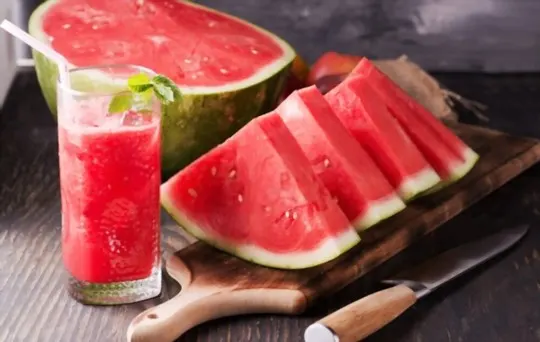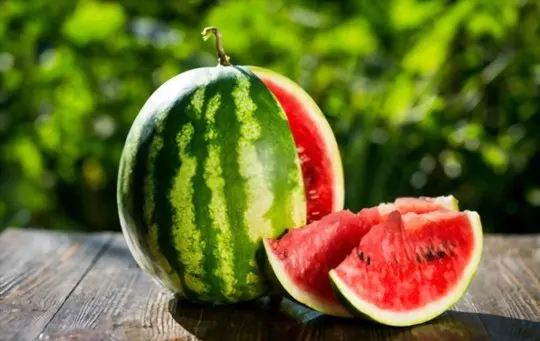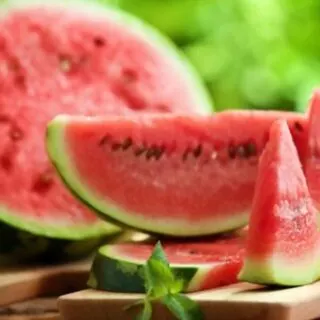Are you always left wondering what this juicy summer fruit really tastes like?
Does it have a unique flavor or is it just sweet and plain? Well, you are in luck!
In this comprehensive guide to all-things watermelon, we will dive deeper into the taste of watermelon and explore how it can be utilized in various dishes.
From its tartness to hints of sweetness, learn why so many people crave watermelon during the hot summer days.
Plus, get some top recipes using fresh or frozen watermelons that showcase the true flavors and impactful taste of this delicious nourishment – allowing you to appreciate its complex flavor profile.
Get ready for an exciting journey as we investigate what does watermelon actually taste like!
What is Watermelon?

Watermelon is a fruit that belongs to the Cucurbitaceae family and is primarily composed of water.
It has a thick green rind that encases juicy red or pink flesh, speckled with black seeds, while some seedless varieties have emerged over the years.
It has a refreshing sweetness that leaves a subtle tart aftertaste, with some varieties having a slightly earthy flavor.
Watermelon is commonly consumed fresh, sliced into pieces, or as a juice or smoothie ingredient.
It is also used in salads, sorbets, and popsicles.
Its high water content makes it a healthy fruit choice, especially during hot summer months when body hydration is essential.
So, if you’re looking for a juicy and refreshing fruit to quench your thirst, watermelon is a perfect choice.
What Does Watermelon Taste Like?

Watermelon is a juicy, refreshing fruit that is perfect for a hot summer day.
Its flavor profile is sweet and subtly tart, with a crisp and crunchy texture.
The taste of watermelon is often described as a combination of strawberries, honeydew melon, and cucumber, with a hint of lime.
The flesh of a ripe watermelon is usually deep pink or red in color and can be eaten raw or used as an ingredient in smoothies, salads, and other dishes.
When choosing a watermelon, look for one that feels heavy for its size, has a uniform shape, and a creamy yellow spot on the bottom where it rested on the ground.
To enhance the taste of watermelon, try drizzling it with a squeeze of lime juice or sprinkling a pinch of salt on top.
Factors that Affect the Taste of Watermelon

Watermelon is a fruit that is predominantly composed of water, but it also contains natural sugars and essential vitamins that make it delicious and healthy.
The taste of watermelon can be influenced by three key factors- genetics, ripeness, and growing conditions.
Genetics play a significant role in determining the flavor profile of watermelons.
Different varieties of watermelon have varying levels of sweetness, crispness, and texture.
Ripeness is also critical in determining the taste of watermelon.
A ripe watermelon should have a yellow underbelly and a hollow sound when tapped.
The flesh should be juicy, have a firm texture and a distinct sweetness.
Growing conditions, such as the amount of sun, water, and nutrients, also have an impact on the taste of watermelon.
Too much or too little of these can affect the quality of watermelon.
In conclusion, the flavor of watermelon is a result of a combination of factors, and it can range from being bland to exceptionally sweet and tasty depending on how it was grown and when it was harvested.
1 – Ripeness
Watermelon is a sweet and refreshing fruit that is a perfect summer treat.
It has a high water content, making it juicy and thirst-quenching.
When it comes to determining ripeness, there are a few things to look for.
You can tell if a watermelon is ripe by its color, texture, and sound.
- Color: Look for a watermelon with a uniform green color and a creamy yellow or white spot on one side where it sat on the ground to ripen.
- Texture: A ripe watermelon should have a slightly rough texture and a dull, matte appearance.
- Sound: When you thump a ripe watermelon, it should produce a deep hollow sound. If the sound is flat or dull, the watermelon is likely underripe.
When you taste a ripe watermelon, expect a bright, sweet, and juicy flavor.
The flesh should be firm yet tender, with a slightly grainy texture.
Pro tip- To enhance the flavor of your watermelon, try seasoning it with a sprinkle of salt or a squeeze of lime juice.
2 – Variety
The taste of watermelon can vary depending on the variety and ripeness, but it typically has a sweet and subtle flavor with hints of refreshing tropical notes.
When choosing a watermelon, look for ones that are free from bruises, firm, and symmetrical in shape.
The ripeness of a watermelon can be determined by tapping it to hear a hollow sound, indicating that it is full of juice.
Watermelon can be enjoyed plain as a snack, blended into smoothies or margaritas, or used in salads, salsas, and desserts.
It is a great source of hydration, vitamins A and C, and lycopene, a powerful antioxidant.
So, next time you indulge in a watermelon, revel in its sweet flavor while reaping its nutritional benefits.
3 – Growing Conditions
Watermelon is a delicious and refreshing fruit with a juicy, sweet flavor and a crisp texture.
Here are the growing conditions for watermelon plants:
- Soil: Watermelons prefer loose, well-draining soil with a slightly acidic pH level (between 6.0 and 6.8).
- Sunlight: Watermelons need full sun exposure (6-8 hours per day) to thrive and produce a good harvest.
- Temperature: Watermelons require warm temperatures to grow, with an optimal range between 75-85°F (24-29°C).
- Water: Watermelons are heavy drinkers, and they require consistent watering to prevent the fruit from cracking or splitting.
Flavor-wise, watermelon tastes sweet, juicy, and slightly tangy, with a crisp and refreshing texture.
How to Choose a Ripe Watermelon?

Watermelon is a refreshing summer fruit with a sweet and juicy taste.
But how can you tell if a watermelon is ripe and ready to eat? Here are some tips for choosing the perfect watermelon:
- Look for a uniform shape and size, without any irregular bumps or dents.
- The watermelon should be heavy for its size, indicating that it is ripe and juicy.
- Check the color of the watermelon’s skin. It should have a dark green color and a dull sheen, without any shiny spots.
- Give the watermelon a tap with your knuckles. A ripe watermelon will have a deep, hollow sound.
- Look for the field spot, the area of the watermelon that rested on the ground. A creamy-yellow field spot indicates that it is ripe.
By following these guidelines, you can select a delicious, ripe watermelon that will be perfect for enjoying on a hot summer day.
How to Eat and Serve Watermelon?
Watermelon is a delicious and refreshing fruit that is perfect for hot summer days.
It has a juicy and sweet taste with a slightly crunchy texture.
Here is a guide on how to eat and serve watermelon:
- Cut the watermelon into triangular slices or into small cubes.
- Serve immediately with a sprinkle of salt or a drizzle of lime juice for an extra burst of flavor.
- Alternatively, you can use a melon baller to scoop out small balls of watermelon for an elegant and fun presentation.
- Watermelon also makes a great addition to fruit salads, smoothies, and cocktails.
Enjoy the sweet and juicy taste of watermelon in different ways and explore all that this delicious fruit has to offer.
Conclusion
In conclusion, watermelon is a refreshing and delicious fruit that is perfect for summertime snacking.
It is a nutrient-dense fruit that is low in calories, high in water content, and rich in vitamins and minerals.
When perfectly ripe, watermelon tastes sweet and juicy with a crisp texture.
The taste of watermelon can vary depending on the specific variety, with some being sweeter or more flavorful than others.
Whether eaten fresh off the rind, blended in a smoothie, or used as a base for a summertime cocktail, watermelon is a versatile fruit that can be enjoyed in numerous ways.
So next time you’re looking for a healthy and refreshing snack, reach for a juicy slice of watermelon.

What Does Watermelon Taste Like? A Comprehensive Guide
Ingredients
- Watermelon
- Ingredients from your selected recipes
Instructions
- Select ingredients that work well together.
- Use a recipe or method that will enhance their natural taste.
- Taste and adjust the recipe as needed to achieve the desired flavor.

Carrie is a food writer and editor with more than 15 years of experience. She has worked for some of the biggest names in the food industry, including Bon Appétit, Food & Wine, and Martha Stewart Living.
As the Editor in Chief of IntroChicago.com, Carrie oversees all of the content on the site. She also manages the team of contributing writers and editors, who help to create delicious recipes, helpful tips, and informative articles that you’ll find on the site.
A native of the Chicago area, Carrie is passionate about all things food. She loves trying new restaurants and experimenting with new recipes in her kitchen. She’s also a graduate of the Culinary Institute of America, so she knows a thing or two about food!
